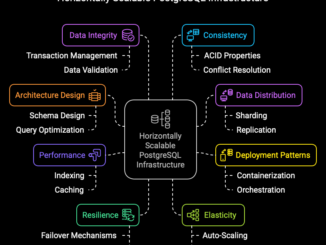PostgreSQL does not have a dedicated Row Store Index as a specific index type because it fundamentally follows a row-oriented storage model where data is stored row by row in tables. However, PostgreSQL supports a variety of index types and features that can achieve similar goals depending on the use case.
Understanding Row Store Index
- A Row Store Index is typically associated with databases that use columnar storage, where a separate index or mechanism exists to facilitate fast retrieval of rows across columns.
- In PostgreSQL, the default storage format is row-oriented, and therefore, data retrieval is already row-based. Index types in PostgreSQL optimize access to specific rows based on column values, eliminating the explicit need for a row store index.
Index Types in PostgreSQL Relevant to Row Store Needs
PostgreSQL provides multiple index types that support efficient row retrieval based on conditions:
1. B-Tree Index (Default)
- B-Tree is the most commonly used index type, and it supports equality and range queries efficiently.
- Use Case: Retrieve rows based on ordered or unique values in columns.
- Example:
CREATE INDEX idx_orders_customer_id ON orders (customer_id); SELECT * FROM orders WHERE customer_id = 12345;
2. GIN (Generalized Inverted Index)
- Designed for indexing composite data types like arrays, JSONB, or full-text search.
- Use Case: Efficient retrieval of rows with array or document-based data structures.
- Example:
CREATE INDEX idx_orders_meta ON orders USING GIN (meta);
SELECT * FROM orders WHERE meta @> '{"key": "value"}';
3. BRIN (Block Range Index)
- Stores metadata for ranges of table blocks, optimized for sequential access to rows.
- Use Case: Works well for large tables where data is inserted sequentially, such as logs or time-series data.
- Example:
CREATE INDEX idx_transactions_date ON transactions USING BRIN (transaction_date); SELECT * FROM transactions WHERE transaction_date BETWEEN '2023-01-01' AND '2023-01-31';
4. Covering Index (INCLUDE Clause)
- Extends a B-Tree index to include additional columns that are not part of the index key but can be fetched directly.
- Use Case: Avoids fetching rows from the heap for queries using indexed columns and included columns.
- Example:
CREATE INDEX idx_orders_customer_id_incl ON orders (customer_id) INCLUDE (status, created_at); SELECT status, created_at FROM orders WHERE customer_id = 12345;
PostgreSQL Features That Simulate Row Store Index Behavior
1. Index-Only Scans
- PostgreSQL supports Index-Only Scans, where the index itself contains all the data needed for a query, eliminating the need to access the main table (heap).
- How it Helps: Works like a "row store index" by fetching data efficiently if all required columns are in the index.
- Example:
CREATE INDEX idx_orders_customer_id_status ON orders (customer_id, status); SELECT customer_id, status FROM orders WHERE customer_id = 12345;
2. Materialized Views
- Materialized views can act as a precomputed row store, providing optimized access to commonly queried row combinations.
- How it Helps: For repetitive complex queries, the materialized view serves as a "snapshot" of rows.
- Example:
CREATE MATERIALIZED VIEW mv_orders_summary AS SELECT customer_id, COUNT(*) AS total_orders FROM orders GROUP BY customer_id;
3. Partitioning
- Declarative partitioning allows dividing a table into smaller, row-oriented storage units based on column values.
- How it Helps: Limits the rows scanned by queries to specific partitions, mimicking row store indexing behavior.
- Example:
CREATE TABLE transactions (
transaction_id SERIAL,
transaction_date DATE,
amount NUMERIC
) PARTITION BY RANGE (transaction_date);
When to Use Alternatives
If you're looking for advanced row-based optimizations that mimic a row store index, consider using:
- TimescaleDB (PostgreSQL Extension): Provides native support for time-series data and row-oriented optimizations.
- Columnar Storage: Use extensions like cstore_fdw for columnar data storage if the workload involves analytical queries.
Conclusion
PostgreSQL does not explicitly have a Row Store Index because its default row-oriented storage and various index types (e.g., B-Tree, BRIN, GIN) already optimize row-based access. Features like index-only scans, covering indexes, and partitioning provide functionality equivalent to row store indexing in most use cases.
Implementing the Materialized Path Model in PostgreSQL: A Step-by-Step Guide


